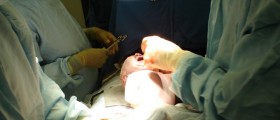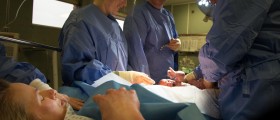
Labor and delivery doesn't typically involve a lot of blood at all. If you have a normal, uncomplicated vaginal birth, you can expect to see less blood at the actual delivery than you do during a typical menstruation. Unlike on films, the baby who has been resting safely inside the amniotic sac filled with amniotic fluid doesn't come out all bloody either. Your newborn may have some "goo" including a white substance called vernix, but there normally won't be much blood.
As your placenta is delivered, some blood will leave your body. Most of it will stay inside the placenta, and you won't see much of it. Postpartum hemorrhage is heavy blood loss following delivery. If you hemorrhage, you will see a fair amount of blood, and you might even have a blood transfusion.
At a typical cesarean section, there is more blood. However, if you have a c-section, you won't necessarily see the blood yourself, unless perhaps you opt for a so-called family centered cesarean section. Generally, there will be a sterile field surrounded by sterile fabric, and you will see a stitched up incision by the time you get to that area yourself. After you have given birth, you will have postpartum bleeding, called lochia, for around six weeks. This lochia will give you the opportunity to see a lot more blood than you would ever come across at a typical labor and delivery so stock up on maternity pads!
- www.nhs.uk/conditions/pregnancy-and-baby/you-after-birth/
- Photo courtesy of Mamma Loves by Flickr: www.flickr.com/photos/mammaloves/4154100272/
















Your thoughts on this
Loading...